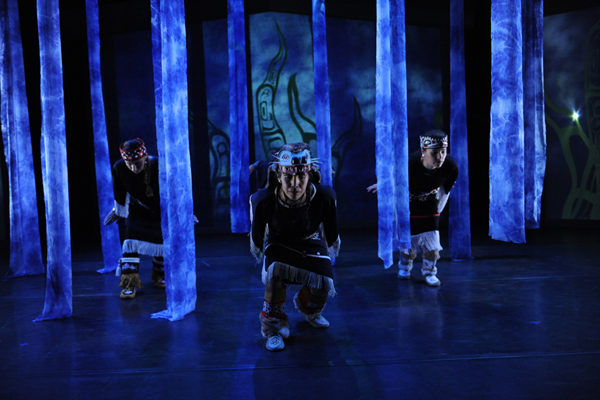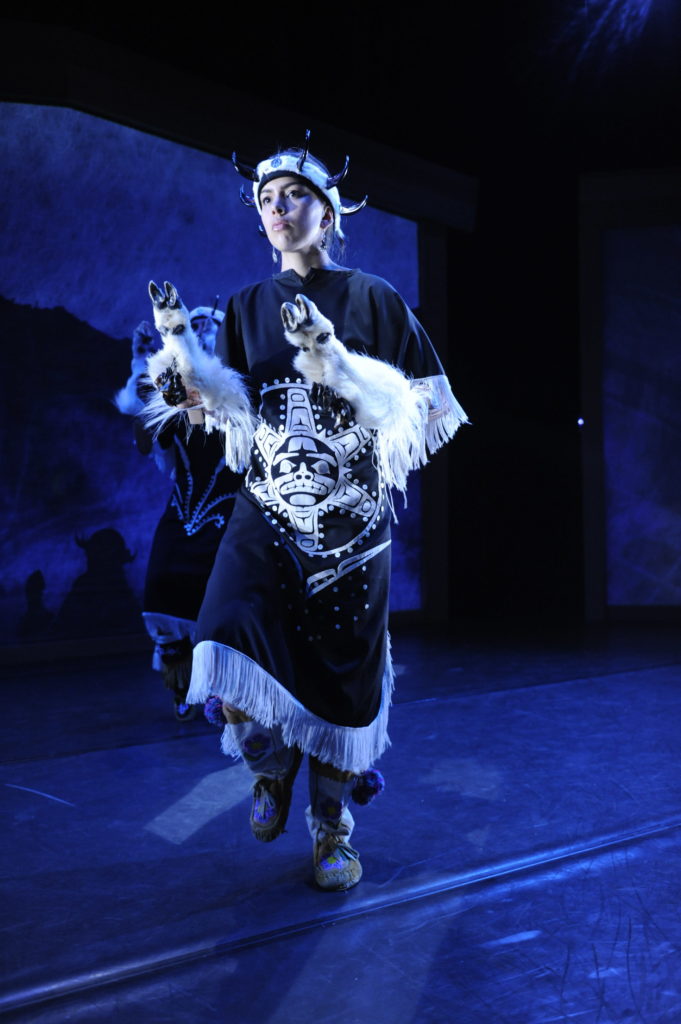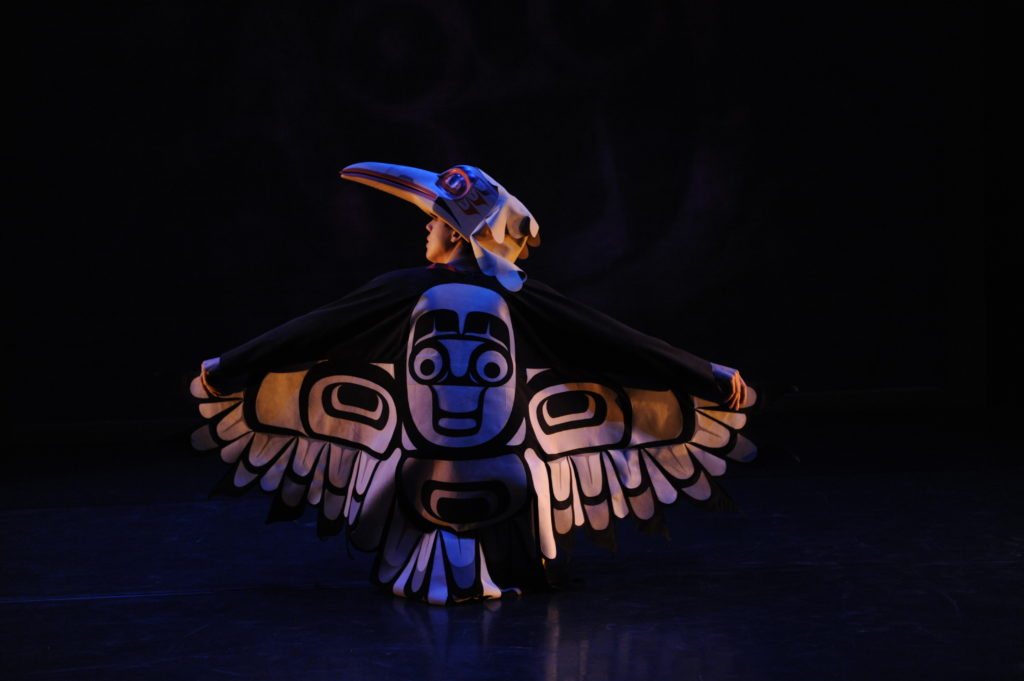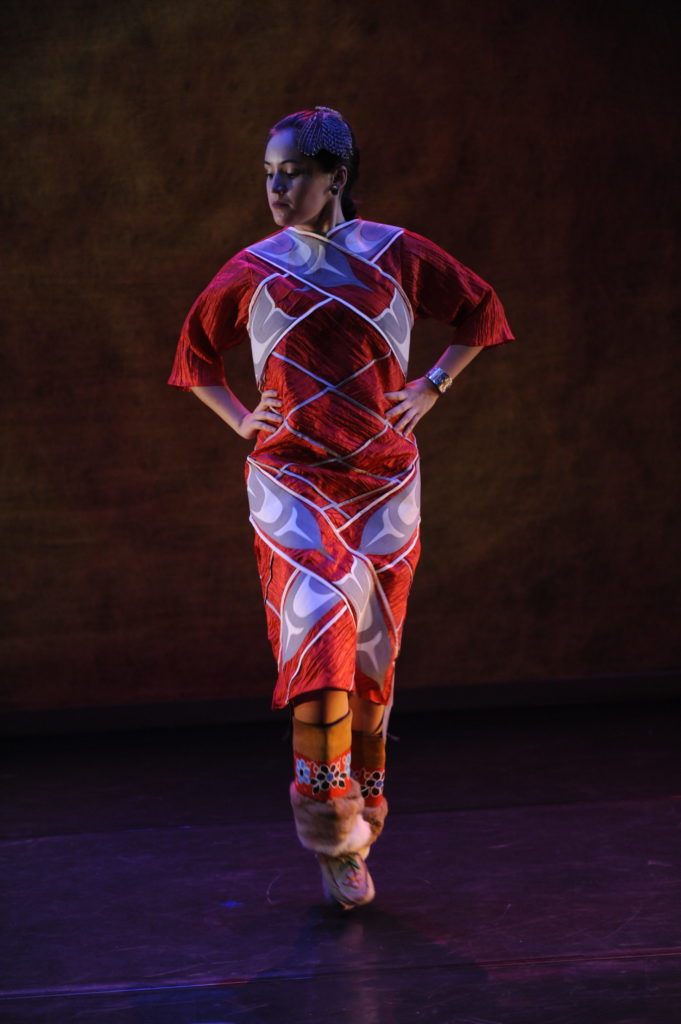
If you haven’t seen Dancers of Damelahamid work their magic yet, the Cultch is giving you the opportunity of a lifetime this week. Brace yourself to witness one of the most important works of contemporary Canadian art. Dancers of Damelahamid are an aboriginal dance company who create breathtaking indigenous dances that make indigenous culture and artforms accessible for the next generation. “Flicker” promises to be a sceno-graphic hybrid of projected environments and live-action Shadow dance. In coastal indigenous culture, a flicker is a woodpecker that represents duality and who is also a portal to the spirit world, and a metaphor for human introspection. “Flicker” will run at the Cultch from the 25th of May to the 29th. We spoke to Margaret Grenier, executive and artistic director of Dancers of Damelahamid, to find out more about “Flicker” and the vision behind the visually rich multimedia show.
What is the premise of “Flicker”?
The dance is set in a forest. The narrative follows the main character, a young man, preparing himself to go on a hunt. On the hunt, he comes across two mountain goats and realises they can come in and out of the spirit world. The man is guided by a number of different beings through the dance, but the main spirit that guides and transforms him is the flicker.
How are the different schools of indigenous dance, like the masked dance for example, woven into the dances?
The foundation of the dances, in terms of the forms and the vocabulary of the movement, is West Coastal dance. All the different nations have their own stories and dances that have been passed down communities and family lineages. Our family began dancing in the 1960s after the Potlatch Ban was lifted. We learned the dances from our elders, after having no dance for about 70 years. The elders taught the dances from their memories rather than their movements. West Coast dance has been strengthened over the last few decades since.
We are a West Coast company but we are also bringing in other vocabularies and movements. For instance, in this piece, there is influence of Powwow dance and Contemporary dance. These influences are reflective of the contemporary influences that we see in our communities today.

How are Shadow dances incorporated into the show?
“Flicker” is a multimedia piece. We have three screens- two screens with projections on the side, and the third centre screen, called the scrim, that you can see through but also project upon. The story is told by the dancers and their regalia, but also via the projective environment. The dancers dance in front of and behind the screen, which allows them to step in and out of the story, step in and out of the present tense, and step in and out of the spirit world.
The show features West Coast graphic design as well. What is distinctive about this particular genre of prints and designs?
West Coast design is relatively abstract. When you look at the design of the flicker, you see the head, the wings and the body. If you were to dissect these elements further you would see that everything is made up of two primary elements. The main element is the ovoid and the second element is the split U, which represents the shape of the flicker’s tail. This quality of independent standalone pieces coming together to form a coherent bigger picture is a prominent feature of West Coast design. It is also the metaphor that we use in “Flicker”. The smallest movement maintains a connection to the traditional form and enables us to express ourselves beyond borders.
Is the show interested in honouring the traditional dances but also in updating them?
I think it is our responsibility to honour and practice what we have been taught but to also find places where things might evolve. We need to ensure that there is not too much fear around change. It is also important to be responsible for future generations. We are the connection between the past and the future.

What was your own journey into indigenous dance? Did you start off in indigenous dance or did you start off with other dances that were more accessible to you?
I was really fortunate to grow up with song and dance that was indigenous to my community. It built a very strong foundation in dance for me, which I was then able to use to communicate with other styles of dance. If the foundation is weak it becomes difficult to have integrity when we try to explore new possibilities.
Do you think indigenous dance is becoming really popular or are you worried that it is going in the opposite direction?
It is my experience that there is interest. Indigenous dance is passed down orally and is movement based. It is not documented well. Our languages are not properly documented. There are all these aspects of our culture that can be lost so easily. Despite the interest, we have to be very conscientious to ensure that the practice continues to be strengthened. It was so close to being lost forever and that really isn’t that far back in our history.
How did you find inspiration for the choreography?
Our dances are intimately connected to our family. We sourced our dances from our daily lives, as well. That is the best way we can represent the culture. When you are representing something that is not mainstream, something that the majority of people don’t have an awareness of, you end up having to represent a lot and carry a lot of responsibility. People take your understanding and generalise it into a broader understanding of aboriginal people. So it is really important that you be true to yourself and your experiences.
We try to be as reflective as we can of our true selves. We are not representing everyone but by representing ourselves authentically we can bring the best understanding of our culture.

You have toured around Canada and internationally. What has the experience been like so far?
We have toured across British Columbia and all over Canada. We’ve also done a fair amount of international touring in New Zealand, Australia, South America and Germany. We had many great opportunities to collaborate with other indigenous communities in these countries too.
What has the reception been like abroad?
There is a large global community that supports one another when it comes to indigenous dance. Even though our histories, cultures and languages are different, the importance of dance as a way to connect with tradition and identity, binds us profoundly. That intention translates to many communities who have similarly experienced near loss of language and culture.
How would you describe the overall message or the vision of the show?
“Flicker” represents moments we all have that give us access to expand ourselves beyond what we are familiar with. We had those moments as artists when we created the show.
The show has been three years in the making and has taken a lot of time and effort. We wanted to challenge ourselves by asking questions about our identity and heritage. Defining indigenous cultural identity is a very complex thing. Sometimes it is easier to just ask- what does it mean to be aboriginal? What does it mean to be Metis? But then we realise we are a lot more complex than that. We have a lot of influences that define us.
That is what “Flicker” is to me. It is about exploring areas that are not obvious but are important to deepening our understanding of our own selves.
Get your tickets here!
-Prachi Kamble
